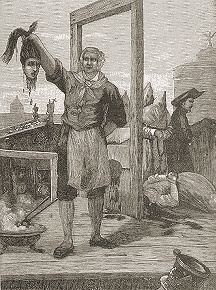
Giovanni Battista Bugatti
Encyclopedia

Executioner
A judicial executioner is a person who carries out a death sentence ordered by the state or other legal authority, which was known in feudal terminology as high justice.-Scope and job:...
for the Papal States
Papal States
The Papal State, State of the Church, or Pontifical States were among the major historical states of Italy from roughly the 6th century until the Italian peninsula was unified in 1861 by the Kingdom of Piedmont-Sardinia .The Papal States comprised territories under...
from 1796 to 1865. He was the longest-serving executioner in the States and was nicknamed Mastro Titta, a Roman corruption of maestro di giustizia, or master of justice. At the age of 85, he was retired by Pope Pius IX
Pope Pius IX
Blessed Pope Pius IX , born Giovanni Maria Mastai-Ferretti, was the longest-reigning elected Pope in the history of the Catholic Church, serving from 16 June 1846 until his death, a period of nearly 32 years. During his pontificate, he convened the First Vatican Council in 1869, which decreed papal...
with a monthly pension of 30 scudi
Italian scudo
The scudo was the name for a number of coins used in Italy until the 19th century. The name, like that of the French écu and the Spanish and Portuguese escudo, was derived from the Latin scutum . From the 16th century, the name was used in Italy for large silver coins...
.
Biography
He referred to his executions as justices and the condemned as patients. His first execution was on March 22, 1796. Up until 1810, the method of execution was beheading by axe, hanging or mallet. The French introduced the use of the GuillotineGuillotine
The guillotine is a device used for carrying out :executions by decapitation. It consists of a tall upright frame from which an angled blade is suspended. This blade is raised with a rope and then allowed to drop, severing the head from the body...
which was continued after the Papal States regained their sovereignty (first beheading by guillotine under papal reign: 1816) until the last executions. He carried out a total of 516 executions.
Bugatti is described as being short and portly, and always well dressed. He frequented the church Santa Maria in Traspontina
Santa Maria in Traspontina
Santa Maria in Traspontina is a Carmelite church in Rome, Italy.The shrine lies on the Via della Conciliazione, the main road of the Rione Borgo....
. He was married but had no children. When not carrying out his official duties, Bugatti and his wife sold painted umbrellas and other souvenirs to tourists.
He could not leave the Trastevere
Trastevere
Trastevere is rione XIII of Rome, on the west bank of the Tiber, south of Vatican City. Its name comes from the Latin trans Tiberim, meaning literally "beyond the Tiber". The correct pronunciation is "tras-TEH-ve-ray", with the accent on the second syllable. Its logo is a golden head of a lion on a...
neighborhood unless on official business. Officially this was for his own protection, in case relatives of those he had executed decided to take revenge against him. Unofficially it was probably due to superstition regarding his part-time job. On his crossing the bridge, the residents of Rome were alerted that an execution was about to take place and people would gather to witness the popular event.
One of his executions, carried out on 8 March 1845 was described by Charles Dickens
Charles Dickens
Charles John Huffam Dickens was an English novelist, generally considered the greatest of the Victorian period. Dickens enjoyed a wider popularity and fame than had any previous author during his lifetime, and he remains popular, having been responsible for some of English literature's most iconic...
in his work Pictures from Italy
Pictures from Italy
Pictures from Italy is a travelogue by Charles Dickens, written in 1846. The book reveals the concerns of its author as he presents, according to Kate Flint, the country "like a chaotic magic-lantern show, fascinated both by the spectacle it offers, and by himself as spectator".-Background:In...
.
His blood
Blood
Blood is a specialized bodily fluid in animals that delivers necessary substances such as nutrients and oxygen to the cells and transports metabolic waste products away from those same cells....
-stained clothes, axes and guillotines are on display at the Museum of Criminology at Via del Gonfalone. The guillotine is of a very peculiar build, with straight blade and V-shaped neckpiece.
External links
- Mastro Titta, page on Bugatti, Website of Museo Criminologico, Rome
- Papal guillotine, Website of Museo Criminologico, Rome Mastro Titta, il boia di Roma: Memorie di un carnefice scritte da lui stesso

